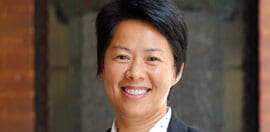The Pioneer Behind Australia’s First National Suicide Prevention Research Fund

Suicide Prevention Australia research fund director Sue Murray.
12 February 2018 at 8:29 am
Sue Murray is the research fund director at Suicide Prevention Australia, who has pioneered the creation of a dedicated national suicide prevention research fund. She is this week’s Changemaker.
Murray moved from education into the community sector, undertaking roles at the NSW Cancer Council and the Leukaemia Foundation, before leading the National Breast Cancer Foundation as CEO for 10 years.
In 2012, she joined Suicide Prevention Australia (SPA) as CEO. During her five year tenure in the role, she introduced the concept of a dedicated national suicide prevention research fund in Australia and successfully led a campaign to get it funded by federal government.
As a result, SPA was appointed by the federal government last June to be the lead agency of the $12 million fund, and Murray stood down as CEO to assume the role of research fund director in January.
In this week’s Changemaker, Murray describes how education continues to lie at the heart of everything she does, explains the importance of a dedicated suicide prevention research fund and outlines some of the challenges involved in being a not-for-profit CEO.
How did you come to be involved in the community sector and what is your history working in it?
I think serendipity has played a very big part in my career path and that really meant I’ve been fortunate to have opportunities presented to me and when that door is open I’ve taken it, not really knowing where it was going to lead me. I began my career in education and I think education continues to lie at the heart of everything that I do. I think it’s critical to bring about true behaviour change in our community. Particularly in relation to health and health behaviours.
So I had the opportunity to get into curriculum development and really be at the forefront of bringing about change in the way school programs were designed and delivered. That was very exciting to me.
Through that connection I then was seconded across to the NSW Cancer Council and there I saw the opportunity to be focused in a particular area which I came to understand was much broader than just cancer. But education still sat then at the heart of what I did and I think what was incredibly important to me at that time was I had two highly creative and visionary people who led me at that time and they made a very big impression on me and really set me on the path to [becoming] a Changemaker. I really wanted to see how I could influence, not just individual lifestyles and healthy behaviors, but how I could really bring about change across the world. And that was really my entree to the community sector and I’ve stayed there ever since.
You have just finished up as CEO of SPA. What do you see as your biggest achievements from running the organisation?
So one of the things I recognised before coming to SPA was that my real strengths lie in growing and building, not in running large organisations. And so when I looked at my background with the National Breast Cancer Foundation, it grew from a few people to 40 people and from turnover of less than $1 million to turnover of more than $20 million within the 10 year period I ran it.
And so that gave me some good insight into myself. What I like to do is find roles where I’m going to save lives. I’m very keen about keeping people well. I want to know that I am going to elevate an issue on the public agenda and I want to know that it’s going to be intellectually challenging to me. And SPA at the time that I came to it, ticked all three boxes for me.
So in the time that I’ve been here we have re-positioned the focus of the organisation. We are focused on ensuring that suicide prevention is high quality, that it’s focused, and that there are collaborative approaches to it in Australia. The organisation has remained small so that it can be nimble. We have recently been awarded the management of the federal government’s $12 million suicide prevention research fund and that’s really brought a significant change in the organisation’s focus.
You have just taken on this new role as research fund director at SPA. Why is a dedicated suicide prevention research fund so important?
Research is the foundation on which we need to build all quality programs. We need to understand what works, for whom it works and why it works. And it’s research that gives us the answers to that. Based on that, we then have the evidence to design, deliver and measure programs and services. Suicide prevention research was significantly underfunded compared to other areas of mental health research and so SPA took a lead on developing a national research action plan. And part of that was to ensure that we got greater investment in research funding. So our work over the last couple of years has been to advocate with the government to secure that funding.
Now having secured the funds, SPA is responsible for enhancing and building that fund over the next three years so that it becomes sustainable. And we also have the responsibility to shift the research agenda from being driven by research interest to being driven by strategic priorities. That way, we’re going to be investing in research that is going to deliver the best outcomes for those who are delivering programs and services, which means that those who are the beneficiaries of this are going to receive the best outcomes for themselves.
What are some of the day-to-day duties involved in this role of research fund director?
So firstly there’s understanding the research environment and becoming familiar with those who are already funding research and looking at where there are opportunities to partner with existing funding agencies in probably a co-funding role. It’s understanding what the priorities are for our research funding and we’ve been fortunate to have the support of the University of Melbourne to help us do that.
It will be identifying where research is actually going on at the moment because a lot of research doesn’t necessarily get funded through the National Health and Medical Research Council. So there may be research that is going on through specific organisations, to other funding agencies, through state governments, through research institutes or hospitals. There’s lots of environments where research can actually be undertaken.
So it’s mapping those research environments and then trying to understand what is the depth of activity going on at the moment. So there’s a lot of advocacy work and relationship work that I will have to do before we actually shift that whole dial in to all of our research being funded in line with strategic priorities. Then there is going to be a whole lot of administrative work. There will always be meetings, there will always be emails and there will always be administration.
What are some of the biggest challenges in running a not for profit like SPA that an incoming CEO will have to deal with?
One of the things that is hard for the broader community to understand is that there are factors involved in research that do not relate to health and well-being. Satisfaction may be related to areas quite outside the health field, like employment and homelessness and financial pressures and relationship breakdowns.
I think to strengthen and grow the membership of SPA, the incoming CEO has a real challenge to convince those who sit outside the health arena that they have a role to play in suicide prevention. We need to grow the membership of SPA so that we can strengthen the focus to build the collaborations and to ensure that the services that are being delivered still continue to be high quality.
So that will be a big challenge. I think always the issue for everybody working in the community sector is the challenge of funding and when funding cycles complete our incoming CEO will have about 18 months in which to ensure that our ongoing government funding is secured but also building up those other revenue streams so that the organisation retains its sustainability.
How do you balance your work life to find time for yourself and what do you like to do in your spare time?
SPA and suicide prevention is an all-consuming area to have been working in, certainly in the last five years. What I plan to do as I shift into a more focused role, is to spend a bit more time on the golf course, spend a bit more time travelling and maybe just get the opportunity to sit down and read a book, not read a publication or a journal or another report on an area of suicide prevention.
Do you have a favorite saying that guides the work that you or the organisation does?
You know, I have always loved that Margaret Mead saying: “Never believe that a few caring people can’t change the world, for that’s all who ever have”. And then from a work perspective I think: “What’s the next big idea we’re going to deal with?”







